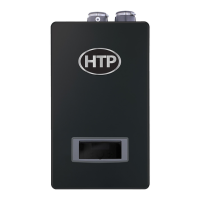22
LP-520 REV. 5.1.17
3. This appliance is designed to be installed in a power vent (using indoor air for combustion and vented to the outdoors) type, or as a
direct vent (sealed combustion) type. In power vent installations, indoor air is used for combustion and exhaust gases are vented
directly to the outdoors through a sealed exhaust vent piped through the wall or roof. In direct vent installations, combustion air must be
supplied directly from the outdoors to the burner, and the flue (exhaust) gases should be vented directly to the outdoors through the
wall or roof.
4. This appliance uses 2” or 3” diameter pipe for exhaust vent and intake pipe. It is important to ensure an airtight seal from the
appliance collar to the vent terminations. See Table 9 for a list of Approved Vent Materials.
5. Do not install venting system components on the exterior of the building except as specifically required by these instructions.
• Vent terminals must be at least 1 foot from any door, window, or gravity inlet into the building.
• Maintain the correct clearance and orientation between the exhaust vent and intake pipe terminals.
• The exhaust vent and air intake terminals must be at the same height and their center lines must be spaced apart 1 foot
minimum.
• The bottom of the exhaust vent and intake pipe terminals must be at least 1 foot above the normal snow accumulation level. In
no case should these terminals be installed less than 1 foot above normal snow accumulation level.
• Do not install the exhaust vent terminals directly above windows or doors.
• Intake pipe terminal must not terminate in areas that might contain combustion air contaminates, such as near swimming
pools.
• For sidewall venting, the minimum horizontal distance between adjacent exhaust vent terminations is 1 foot. It is
recommended this distance be greater than 1 foot to better avoid frost damage to building surfaces.
• For roof venting, minimum horizontal distance between any adjacent exhaust vent termination is 1 foot.
• If the exhaust vent is to be terminated in a walled off area (such as a roof with a parapet wall), ensure the exhaust vent
terminates a minimum of 10' from nearest wall and extends level with or above the top of the wall. This will ensure flue gas
does not get trapped and possibly recirculated into the intake air pipe, which could contaminate the combustion air.
• Do not locate vent over public walkways, driveways, or parking lots. Condensate could drip and freeze, resulting in a slip
hazard or damage to vehicles and machinery.
• DO NOT vent near soffit vents, crawl space vents, or other areas where condensate or vapor could create a nuisance or
hazard or cause property damage.
• DO NOT vent where condensate vapor could cause damage or could be detrimental to the operation of regulators, relief valve,
or other equipment.
• DO NOT vent the water heater in a chimney flue serving a separate appliance designed to burn solid fuel. The water heater
may only be vented in vacant chimneys.
• Maximum Snow Level Determination: These installation instructions reference snow levels in establishing a minimum height
for the installation of exhaust vent or air intake terminations. Snow levels shall be determined as follows:
a. The installation location may, by ordinance, designate how snow levels are calculated in that location; or
b. In the absence of specific ordinances, snow levels shall be calculated from the average monthly maximum depth of snow
accumulation as indicated by the National Weather Service’s 10 year statistics for the installation location/geographical
area.
In addition:
• Total length of vent piping shall not exceed the limits specified in this manual.
• The vent piping for this direct vented appliance is approved for zero clearance to combustible construction.
• The flue products coming from the exhaust vent will create a large plume when the heater is in operation. Avoid venting in
areas that will affect neighboring buildings or be considered objectionable.
• DO NOT locate exhaust vent or intake pipe in a parking area where machinery may damage the pipe.
In the Commonwealth of Massachusetts and as Required by State and Local Codes:
• The vented gas fueled appliance shall not be installed so its combustion, ventilation, or dilution air is obtained from a bedroom
or bathroom.
• Signage: Whenever any through-the-wall (horizontal or sidewall) vent is installed less than seven feet above the finished
grade, a metal or plastic identification plate shall be permanently mounted to the exterior of the building at a minimum height of
eight feet above grade directly in line with the exhaust vent terminal. The sign shall read, in print no less than 0.5 inches in
size, “GAS VENT DIRECTLY BELOW. KEEP CLEAR OF ALL OBSTRUCTIONS”.
• Marking of Exhaust Vent and Intake Pipe: Piping used for ventilation, make-up, or combustion air intake shall be labeled as
follows:
a. Throughout the entire developed length:
i. Labels must be placed every ten feet for exposed/visible piping; or
ii. Labels must be placed every three feet for concealed piping.
b. At all changes of direction;
c. On each side of a penetration through a partition, wall or ceiling; and
d. The labels shall be black lettering that:
i. Indicates that the piping is used for ventilation, make-up, or combustion air intake, and
ii. The letters shall be sized equal to a minimum of the pipe diameter. However, for piping with a diameter exceeding
two inches, said lettering does not need to be larger than two inches.

